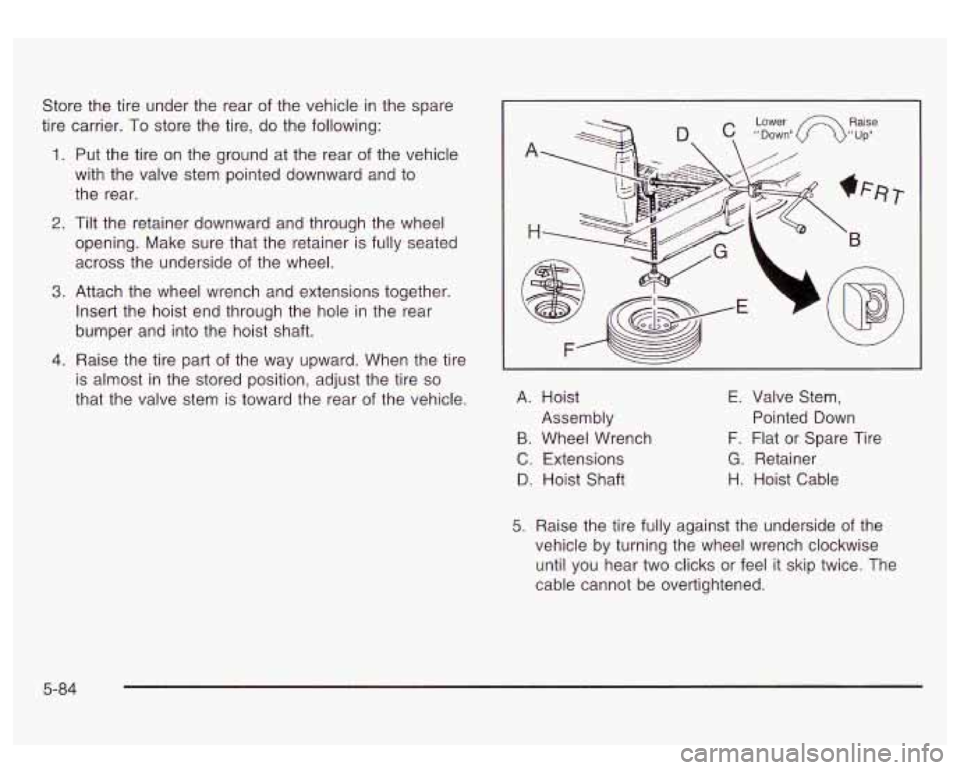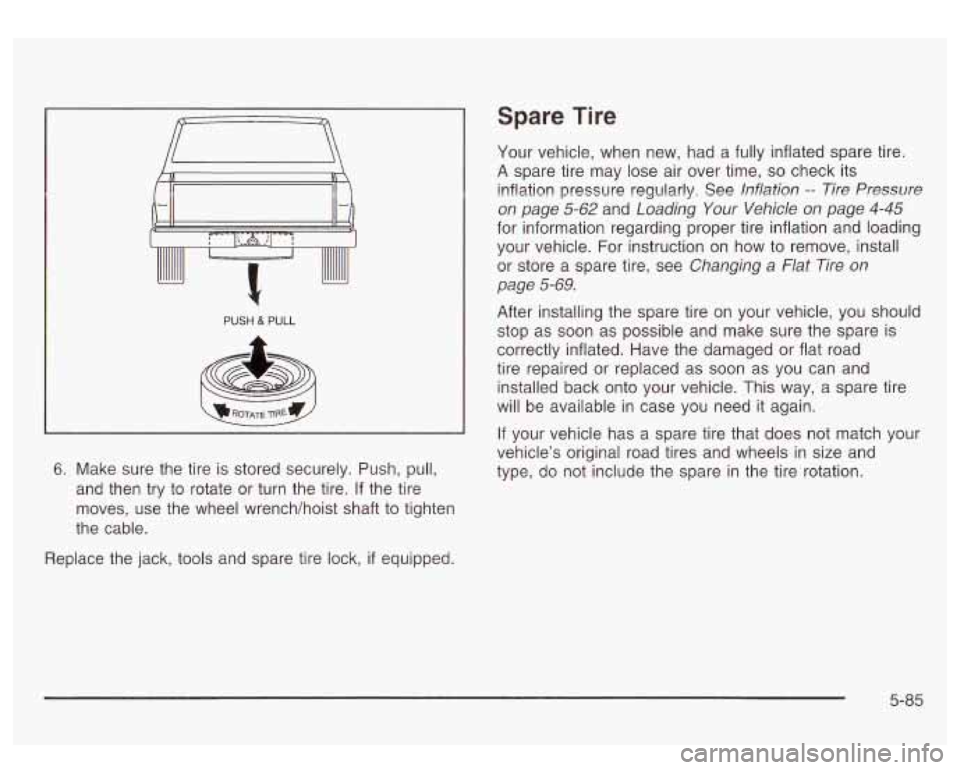Page 346 of 428
Removing the Flat Tire and Installing
the Spare Tire
1. Use the wheel wrench
to loosen all the wheel
nuts. Turn the wheel
wrench
counterclockwise to
loosen the wheel nuts.
Don’t remove
them yet.
la r Front Location RL.
Location
2. Position the jack under the vehicle. If the flat tire is
on the front of the vehicle, position the jack on the
frame behind the flat tire.
If the flat tire is on the rear, position the jack under
the rear axle between the spring anchor and the
shock absorber bracket.
Notice: If your vehicle is equipped with
QUADRASTEERTM avoid contact with tie rods and
tie rod boots when jacking the vehicle.
5-77
Page 348 of 428
Rear Position
3. Make sure the jack head is positioned so that the
rear axle
is resting securely between the grooves
that are on the jack head. Turn the wheel
wrench clockwise to raise the vehicle. Raise the
vehicle far enough
off the ground so there is enough
room for the spare tire to
fit under the wheel well.
4. Remove all the wheel
nuts and take
off the
flat tire.
Rust or dirt on the wheel, or on the parts to
which
it is fastened, can make the wheel nuts
become loose after a time. The wheel could
come
off and cause an accident. When you
change
a wheel, remove any rust or dirt from
the places where the wheel attaches to the
vehicle. In an emergency, you can use a cloth
or
a paper towel to do this; but be sure to use
a scraper or wire brush later, if you need to, to
get all the rust
or dirt off.
5-79
Page 349 of 428
5. Remove any rust or dirt
from the wheel bolts,
mounting surfaces
and spare wheel.
Never use
oil or grease on studs or nuts. It
you do, the nuts might come loose. Your wheel
could fall
off, causing a serious accident.
6. After mounting the
spare, put the wheel
nuts back on with
the rounded end
of the
nuts toward the
wheel. Tighten each
wheel nut by hand.
Then use the wheel
wrench until the wheel is held against
the hub.
5-80
Page 351 of 428

1 in a crisscross
8.
Tighten the nuts firmly
sequence as shown by
turning the wheel
wrench clockwise.
Incorrect wheel
nuts or improperly tightened
wheel nuts can cause the wheel to come loose and even come
off. This could lead to an
accident. Be sure to use the correct wheel
nuts. If you have to replace them, be sure to
get new
GM original equipment wheel nuts.
CAUTION: (Continued) Stop somewhere
as soon as you can and have
the nuts tightened with a torque wrench to the
proper torque specification. See ”Capacities
and Specifications” in the Index for wheel nut
torque specification.
Notice: Improperly tightened wheel nuts can lead
to brake pulsation and rotor damage. To avoid
expensive brake repairs, evenly tighten the wheel
nuts in the proper sequence and to the proper
torque specification. See “Capacities and
Specifications”
in the index for the wheel nut torque
specification.
9. When you reinstall the full-size wheel and tire, you
must
also reinstall the center cap. Place the cap on
the wheel and tap it into place until it seats flush
with the wheel.
5-82
Page 352 of 428
Storing a Flat or Spare Tire and Tools
--xing a jack, a --:e, or ---ier equipment in the
passenger compartment
of the vehicle could
cause injury. In a sudden stop or collision,
loose equipment could strike someone. Store
all these in the proper place.
Notice: An aluminum wheel with a flat tire should
always be stored under the vehicle with the hoist. However, storing
it that way for an extended
period
of time could damage the wheel. To avoid
this, always stow the wheel properly with the valve
stem pointing down and have the wheel repaired
as soon as possible.
Return the bottle jack, wheel blocks, wheel wrench and
jack extensions to their location under the passenger’s
side second row seat. Secure the items in the vehicle as
shown.
Tu
A. Wing Nut F. Storage Bag
B. Wheel Blocks G. Bottle Jack Holder
C. Wheel Wrench and H. Bottle Jack
Extensions Retainer
I. Wheel Block
D. Gloves Retainer
E. Wheel Wrench and
Extensions
5-83
Page 353 of 428

Store the tire under the rear of the vehicle in the spare
tire carrier. To store the tire, do the following:
1. Put the tire on the ground at the rear of the vehicle
with the valve stem pointed downward and to
the rear.
2. Tilt the retainer downward and through the wheel
opening. Make sure that the retainer is fully seated
across the underside of the wheel.
3. Attach the wheel wrench and extensions together.
Insert the hoist end through the hole in the rear
bumper and into the hoist shaft.
4. Raise the tire part of the way upward. When the tire
is almost in the stored position, adjust the tire
so
that the valve stem is toward the rear of the vehicle. A.
Hoist
B. Wheel Wrench
C. Extensions
D. Hoist Shaft
Assembly
E. Valve Stem,
Pointed Down
F. Flat or Spare Tire
G. Retainer
H. Hoist Cable
5. Raise the tire fully against the underside of the
vehicle by turning the wheel wrench clockwise
until you hear two clicks or feel it skip twice. The
cable cannot be overtightened.
5-84
Page 354 of 428

PUSH & PULL
6. Make sure the tire is stored securely. Push, pull,
and then try to rotate or turn the tire.
If the tire
moves, use the wheel wrench/hoist shaft to tighten
the cable.
Spare Tire
Your vehicle, when new, had a fully inflated spare tire.
A spare tire may lose air over time, so check its
inflation pressure regularly. See
Inflation -- Tire Pressure
on page 5-62 and Loading Your Vehicle on page 4-45
for information regarding proper tire inflation and loading
your vehicle. For instruction on how to remove, install
or store a spare tire, see
Changing a Flat Tire on
page
5-69.
After installing the spare tire on your vehicle, you should
stop as soon as possible and make sure the spare is
correctly inflated. Have the damaged or flat road
tire repaired or replaced as soon as you can and
installed back onto your vehicle. This way, a spare tire
will be available in case you need it again.
If your vehicle has a spare tire that does not match your
vehicle’s original road tires and wheels in size and
type, do not include the spare in the tire rotation.
Replace the jack, tools and spare tire
lock, if equipped.
5-85
Page 359 of 428

Windshield and Wiper Blades
If the windshield is not clear after using the windshield
washer, or
if the wiper blade chatters when running,
wax, sap or other material may be on the blade or
windshield.
Clean the outside of the windshield with a full-strength
glass cleaning liquid. The Windshield is clean
if beads do
not form when you rinse it with water.
Grime from the windshield will stick to the wiper blades
and affect their performance. Clean the blade by
wiping vigorously with a cloth soaked in full-strength
windshield washer solvent. Then rinse the blade
with water.
Check the wiper blades and clean them as necessary;
replace blades that look worn.
Aluminum or Chrome-Plated Wheels
Your vehicle may be equipped with either aluminum or
chrome-plated wheels.
Keep your wheels clean using a soft clean cloth with
mild soap and water. Rinse with clean water. After
rinsing thoroughly, dry with a
soft clean towel. A wax
may then be applied. The
surface of these wheels is similar to the painted
surface of your vehicle. Don’t use strong soaps,
chemicals, abrasive polishes, abrasive cleaners,
cleaners with acid, or abrasive cleaning brushes on
them because you could damage the surface. Do not
use chrome polish on aluminum wheels.
Use chrome polish only on chrome-plated wheels, but
avoid any painted surface of the wheel, and buff
off
immediately after application.
Don’t take your vehicle through an automatic car wash
that has silicone carbide tire cleaning brushes. These
brushes can also damage the surface of these wheels.
Tires
To clean your tires, use a stiff brush with tire cleaner.
Nofice: When applying a tire dressing, always take
care to wipe
off any overspray or splash from all
painted surfaces
on the body or wheels of the
vehicle. Petroleum-based products may damage the paint finish and tires.
5-90